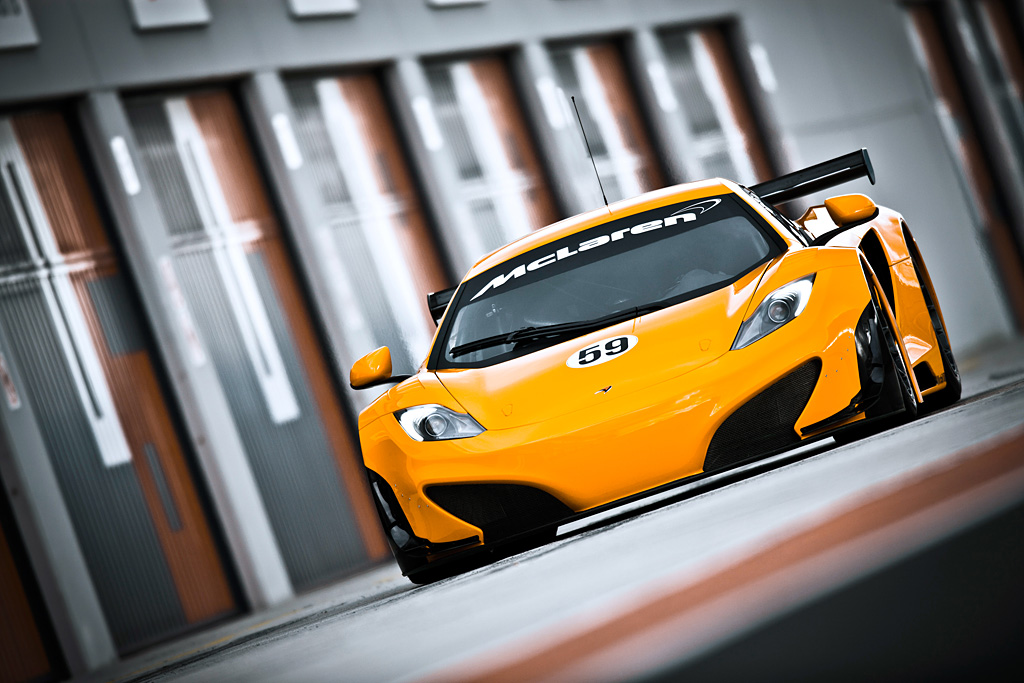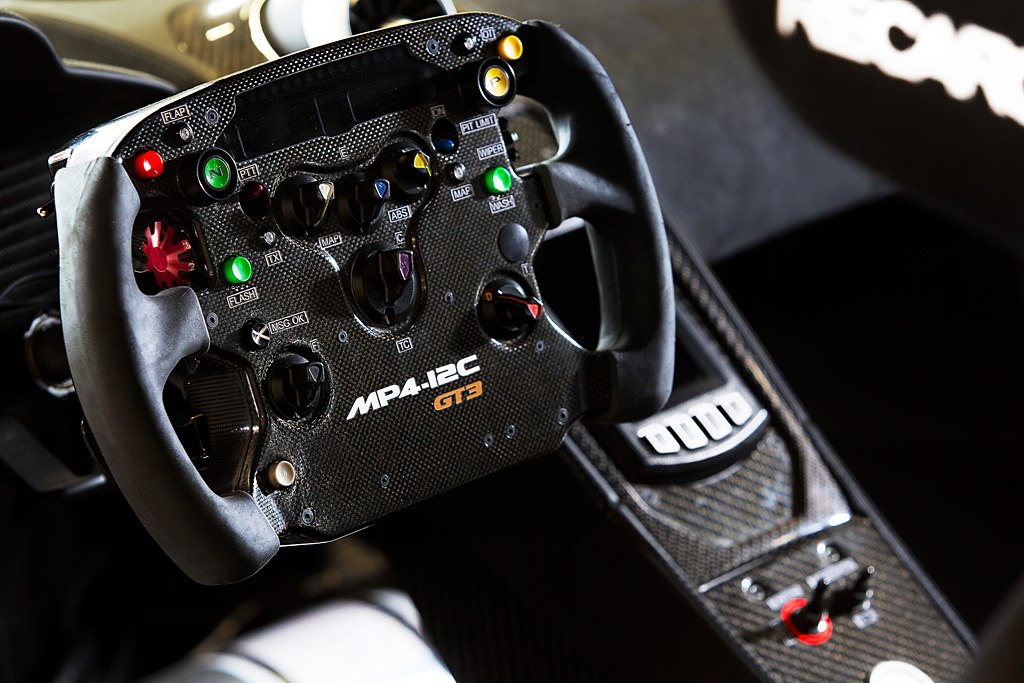2011 McLaren MP4-12C GT3
In 2012 McLaren will take on the best that Porsche, Ferrari Audi and AMG can produce in the GT3 class of racing. Partnered with CRS Racing, McLaren hope to offer teams a competitive package by 2012 by running limited races in 2011.
Press Release.
The new McLaren MP4-12C GT3 will be the first McLaren car built for FIA GT series racing since the McLaren F1 GTR finished production in1997. The 12C GT3 is based on the new MP4-12C high-performance sports car and a team of engineers, designers and test drivers with vast experience in Formula 1 and GT racing has been assembled to undertake the process of adapting the carbon chassis-based 12C to racing specification.
Martin Whitmarsh, McLaren Group Chief Executive Officer said: “McLaren has racing in its blood and it was a natural step to take our MP4-12C road car and turn it into the most reliable, efficient and easy to drive GT3 car. Every car on the grid will have its performance balanced by race rules, meaning our objective must be to select a technical specification that ensures any driver is able to access the 12C GT3’s performance limit with ease.
“We have worked with CRS Racing to ensure the 12C’s design and development programme is as close as possible to one McLaren Racing would employ in developing a Formula 1 car. The team at CRS is well qualified to shape decisions in this area as they have an outstanding record in racing GT3 cars, and understand what is required to be successful in that level of competitive motorsport.
“In return, McLaren Racing is able to bring new levels of technology to GT3 racing. No other GT3 car in 2012 will be supplied with a road-car carbon chassis, or a steering wheel and other associated technology from a Formula 1 car.
“The 12C GT3 will be supplied with the 12C’s carbon MonoCell and the same steering wheel design employed by Lewis Hamilton in his MP4-24 Formula 1 car. Plus, we are working closely with Formula 1 suppliers past and present: Akebono, Mobil 1, McLaren Electronic Systems, Ricardo and Michelin for example. This blend of road car and Formula 1 technology and experience will be a great advantage to anyone racing a 12C GT3 in 2012.”
McLaren MP4-12C GT3 development targets
McLaren GT comprises a team of designers, engineers and test drivers with vast experience in developing successful race and road cars. Marcus Waite, McLaren GT Chief Engineer, began his career working with the McLaren Formula 1 Simulation Group. A move onto the Formula 1 team where he was Senior Test Team Engineer for many years was then followed by his appointment to McLaren Automotive as Test Team Leader responsible for the new MP4-12C sports car. Combining practical experience of Formula 1 car development methodology and a deep understanding of the 12C road car’s technical specification is invaluable to McLaren GT.
Marcus Waite said: “We have defined the technical requirements for the 12C GT3 in the McLaren simulator and I am pleased to say that feedback from the three new drivers in the team means we can immediately focus on fine-tuning the set-up of the car, rather than address any fundamental changes.
“There is no substitute for having the 12C GT3 pound around the European circuits on which we plan to race, so that is exactly what we are doing. A varied circuit programme is vital. Circuito de Navarra in Spain is a great track: a mixture of slow and fast corners and long straights, meaning the new engine calibration we are testing has to undertake relentless accelerations from low speeds. A successful shakedown there means we are now confident of powertrain durability.
“We followed Navarra with a test session atAutódromo Internacional do Algarve in Portugal. The long, sweeping and fast bends of that circuit were a good test for the new oil tank we have designed for the 12C GT3. The oil is constantly moving and yet the new tank proved robust in that environment.
“These are just two examples of the way we will test every component of the 12C GT3 before delivering cars to race teams in 2012. I personally will not be satisfied until we have undertaken test programmes that significantly surpass the requirements of 3hr and 24hr endurance racing. We are committed to dealing with emerging issues that race teams often face in their first season running a new GT3 car and we will ensure our first customers receive a very reliable race car next season.”
Formula 1 simulator readies the new 12C GT3 for its track debut
On March 4th, virtually 30 years to the day that the world’s first carbon-based racing car, the McLaren MP4/1 was shaken down at Silverstone (March 5th 1981), the 12C GT3 also debuted at the UK circuit.
One week later, it took to the Circuito de Navarra in Spain for its first FIA circuit test. These shake down and test sessions followed months of extensive testing on simulated versions of international race circuits including Silverstone, Circuit de Catalunya and Paul Ricard. In simulated tests, McLaren GT was able to fine-tune engine calibration, power steering, spring rates, weight distribution, gear ratios and differential settings.
Mark Williams, Head of Vehicle Engineering at McLaren Racing, said:“The new 12C GT3 was initially developed in the Simulator where we were able to fully explore the parameter space before defining the power, weight and downforce targets. We used Computational Fluid Dynamics (CFD) to develop the aerodynamic configuration and then tested the various map shapes in the McLaren Simulator, working with the McLaren Automotive simulation team to define the vehicle set-up and access the resultant driveability. Being able to review our aero package and car set-up using a simulator developed for Formula 1 prior to first track running is unique. No other GT3 car will have been specified using this level of technology.”
Following the Spanish shakedown session, Andrew Kirkaldy Team Principal at CRS Racing and McLaren GT Project Manager, said: “The performance of the car in Navarra was testament to the work we were able to do in the McLaren simulator in selecting the right set-up for the car. The virtual and real world versions of the 12C GT3 felt near-identical.
“The new aerodynamic body panels and features designed for the 12C GT3 are of outstanding quality and markedly increase the dynamic performance of the car. This level of quality can only be achieved using FE design analysis and knowing how best to apply carbon fibre. McLaren has this knowledge in abundance.
A new aerodynamics package produced entirely from carbon fibre has been developed by McLaren Racing in compliance with GT3 regulations, incorporating a new front splitter, door blade, rear wing, diffuser and louvres in the front fenders.
In partnership with McLaren Applied Technologies, McLaren GT plans to offer its clients the opportunity to develop their 12C GT3 using bespoke programmes in the McLaren Simulator. Chris Goodwin said: “The simulator is a huge competitive advantage to McLaren Racing in developing its Formula 1 cars and to McLaren Automotive in developing its future range of sports cars.
“We recognise that the teams racing the 12C GT3 next year will be ahead of their competitors if they are able to use a bespoke McLaren simulation programme throughout the race season. We plan to announce full details of the simulation programme available to 12C GT3 owners and other potential clients later this year.”
The McLaren MP4-12C: The essence of a race car
Racing experience and development tools have played a key part in readying the 12C GT3 for its 2011 race programme. But, before the racing car takes to the competitive grid, McLaren, in the form of McLaren Automotive set out to develop a high-performance sports car that set new standards for speed, handling, efficiency, braking and driveability: formed from an obsession for aerodynamic purity and lightweight engineering. Assets and goals that make the McLaren MP4-12C a perfect road car from which to develop a race-winning GT car.
Once plans were agreed to take the 12C racing, key members of McLaren Automotive’s design and engineering teams were eager to support this natural step at McLaren.
Mark Vinnels, McLaren Automotive Programme Director, said: “It was an obvious decision to take the 12C racing. From the early stages in the car’s development we were integrating key members of McLaren Racing into the road car development team and this blend of experience and skill, combined with a ‘can-do’ attitude and desire to push what is technically possible, has led to both a great road car and a unique racing car. At the McLaren Technology Centre headquarters we walk past the McLaren F1 GTR that won Le Mans in ’95 every day. Racing has changed since then, and we have no plans to develop a McLaren to win Le Mans outright again, but car number 59 is truly inspirational for us all.”
Frank Stephenson, McLaren Automotive Design Director, said: “Conceptually, the 12C road car and future McLaren road cars are ‘easy’ cars to design. We strive for form that is driven by aerodynamic efficiency, and this rules out arguments over styling or unnecessary bodywork details that can easily become dated as fashions change. Our design team is passionate about designing cars that tell you what’s going on under the skin and remain relevant: we are an engineering company at heart and we shouldn’t hide that fact. That’s why supporting the development of the GT3 car was a great project to work on: the car needs more air to breathe and needs even greater downforce to hug the track. Yet it also has to quicken pulses as it goes about its business. The GT3 car really gets the heart racing!”
Under the McLaren Orange skin, the 12C GT3 shares the same 75kg carbon ‘MonoCell’ chassis as the 12C road car. Since the modern McLaren was formed in 1981, the company has used only carbon fibre for the chassis construction of all its road and race cars: it was a natural choice for the heart of the MP4-12C. Lightweight construction and manufacturing innovation through Resin Transfer Moulding was a priority for the engineers and designers responsible for the 12C’s chassis. The result is a road car that, at1301kg**, is the lightest in the ‘core’*** sector of the high-performance sports car market.
Andrew Kirkaldy said: “I believe the MP4-12C is an engineering masterpiece and that starts with its carbon chassis. A rigid chassis is hugely important to a racing driver. The McLaren MonoCell is unequalled as a safety cell, and our engineers can be sure that any changes made to the chassis set-up will have the desired effect because of its structural rigidity and predictability.
“The 12C is the first road car I have driven on a track and been truly overwhelmed by its dynamic performance. We have had to engineer certain aspects of our GT3 car to race specification, but I can’t think of a better place to start than the new 12C.”
CRS Racing to deliver on expectations of a new McLaren race car
The prevailing design concept of the new McLaren MP4-12C road car is ‘designed around the driver’, and this is just one example of McLaren’s uncompromising commitment to offering a new driving experience in road and race cars. CRS Racing Team Principal Andrew Kirkaldy brings a decade of GT-level racing experience to McLaren GT and, as the team’s project manager, Kirkaldy was able to specify the cockpit and other attributes of the 12C GT3 to ensure restrictions normally associated with GT3 race cars are removed from the McLaren.
Andrew Kirkaldy said: “CRS Racing is delighted to be working with McLaren. The expectations are high and rightly so. Together we share the passion for design, engineering innovation and racing success that will ensure the 12C GT3 is the most competitive in the series from 2012.
“When Martin Whitmarsh first approached CRS Racing I was delighted that his main objective for McLaren GT was to make the needs of customers and drivers an absolute priority. That message transcends everything we are now undertaking. The development programme will be rigorous to ensure reliability, the technical specification of the 12C GT3 will surpass rival cars due to the links we have with Formula 1 technology suppliers, build quality will reflect the high standards introduced in the 12C road car, and the maximum performance will be accessible to drivers of varied experience levels.
“Before McLaren GT, CRS was a customer of race car manufacturers. On occasion, it became accepted that GT cars are unreliable straight out of the box because manufacturers deliver cars before the technology is proven for racing. At McLaren GT we know expectations are higher. We want our customers to experience outstanding performance with metronomic reliability.
“Our combined experience means we can identify problems encountered previously by race teams or drivers and address them. In the cockpit of the 12C GT3 for example, we have ensured that the pedal position is exactly in line with the seating and steering wheel positions. The driving position in many GT3 cars is compromised by comparison.”
Specification and performance reflect McLaren expectations
Just as with the 12C road car, McLaren is working closely with specialist suppliers to deliver an innovative and lightweight car. The 3.8-litre McLaren V8 twin turbo ‘M838T’ engine supplied in the road car also features in the 12C GT3, but de-tuned to 500 PS (from 600 PS) in order to provide optimum power for this performance-balanced race car.
The new MP4-12C GT3 will feature a unique engine calibration, bespoke racing transmission developed in partnership with Ricardo (who also developed the engine with McLaren) and a suspension arrangement tuned specifically for racing.
Mark Williams said: “With the tyre grip balance moving forward on the GT3 racing tyres it was necessary to move the centre of gravity further forward and the only way to do this was to reduce weight at the rear. A six-speed sequential shift gearbox by Ricardo was selected because a race-specific transmission is 80kg lighter than the Seamless Shift, seven-speed gearbox used in the road car. All the internal components have been proven in other racing series. We then challenged Ricardo to reduce weight further, meaning the unit has a bespoke casing design. That is just one example of how we are continually looking to reduce weight and increase efficiency.”
McLaren GT has selected the TAG-400 Engine Control Unit for the new 12C GT3. The TAG-400 is a compact, self-contained engine management system and data logger for race engines designed and built by McLaren Electronic Systems. The procurement of components from suppliers used to working with partners in Formula 1 is another example of McLaren GT delivering on its objective to build a GT3 car of unrivalled quality and reliability.
Williams said: “McLaren GT is a smaller organisation than McLaren Racing, but we are applying Formula 1 methodology in every possible area.
“We have worked with Akebono in Formula 1 for many years, and I am delighted to be able to call on such a committed and reliable partner for McLaren GT. Akebono will supply brake callipers and has also designed a bespoke brake pad for the 12C GT3. Our own experts from McLaren Racing have worked closely with Michelin to develop the correct tyre model for the 12C GT3 simulation programme. And strong supplier relationships are important to the suppliers themselves. I am sure that Mobil 1 and Ricardo will learn a lot working together on advanced lubricants for the 12C GT3’s new transmission.”
MP4-12C GT3: the customer commitment
With a rigorous development programme complete at the end of the 2011 GT3 season, McLaren GT will put in place a robust support programme to ensure all customers of the MP4-12C GT3 are able to stay competitive throughout the 2012 season.
Martin Whitmarsh said: “We speak regularly with prospective customers for the 12C GT3 now and these relationships will only strengthen when teams take delivery of the 20 cars we plan to build for next season.
“This is the first step into GT3 racing for McLaren and we understand that our focus on quality must be consistent through design, development, technology, finish and customer service. I am proud of the relationships McLaren Racing has with sponsors and partners now and I look forward to extending this to customers of the new MP4-12C GT3.”
Initial demand for the first 20 McLaren MP4-12C GT3s is high, with interest suggesting that McLaren and CRS Racing could sell the run five times over. However, neither company has any desire to stretch the market and lead to a risk of either oversupply or restrictions on customer service. Retained value in each GT3 car is also of high priority to McLaren and CRS, and the first customers when they take delivery.
Looking further ahead, around 20 more GT3s plan to be built through 2013 and ’14, but both McLaren and CRS remain open-minded and optimistic about developing racing cars for other series’ and markets.
Andrew Kirkaldy summed up the customer-oriented attitudes at both companies: “We will treat our customers with respect. Having spent time now at McLaren’s amazing headquarters, and seen at close hand their aspiration to launch a new type of sports car company, it is clear that they are, as ever, keen to do things better. Whether this is through race support, parts supply, or even the simple fact that the car’s list price is its price – there are no hidden extras – we want to make doing business with us a pleasure. If we can celebrate race wins together in spring 2012 then even better!”
Story by McLaren
In Detail
| submitted by | admin |
| type | Racing Car |
| released at | 2011 Blancpain Endurance Series at Navarra |
| built at | Woking, England |
| price £/td> | £175,000 |
| engine | 90º M838T V8 |
| position | Mid, Longitudinal |
| aspiration | Twin Turbo |
| block material | Cast Aluminum |
| valvetrain | 4 Valves per Cyl w/VVT |
| displacement | 3800 cc / 231.89 in³ |
| bore | 93 mm / 3.7 in |
| stroke | 69.9 mm / 2.8 in |
| power | 447.4 kw / 600 bhp |
| specific output | 157.89 bhp per litre |
| bhp/weight | 428.27 bhp per tonne |
| torque | 600 nm / 442.5 ft lbs |
| redline | 7500 |
| body / frame | Carbon Fiber Panels over Carbon Fiber Monocoque ‘MonoCell’ w/Front & Rear Sub Frames |
| driven wheels | RWD |
| wheel type | Forged Aluminum |
| front tires | Pirelli |
| rear tires | Pirelli |
| front brakes | Iron Discs w/Akebono 6-Piston Calipers |
| f brake size | 36 x 378 mm / 1.4 x 14.9 in |
| rear brakes | Iron Discs w/Akebono 4-Piston Calipers |
| r brake size | 32 x 355 mm / 1.3 x 14.0 in |
| front wheels | F 45.7 x 30.5 cm / 18 x 12 in |
| rear wheels | R 45.7 x 33.0 cm / 18 x 13 in |
| f suspension | Double Wishbones w/Coil over Multimatic DSSV Dampers |
| r suspension | Double Wishbones w/Coil over Multimatic DSSV Dampers |
| curb weight | 1401 kg / 3089 lbs |
| wheelbase | 2670 mm / 105.1 in |
| width | 1995 mm / 78.5 in |
| height | 1145 mm / 45.1 in |
| transmission | 6-Speed Sequential |
| tran clutch | Sintered Clutch |
| emission | 300 g/km |
| fuel capacity | 120 litres or 31.68 gal. |













